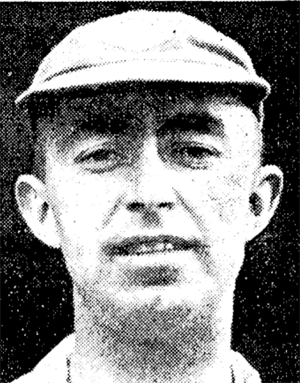Ilikena Lasarusa Talebulamainavaleniveivakabulaimainakulalakebalau was a Fijian cricketer who played nine first-class matches for Fiji between 1947–48 and 1953–54. He was more commonly known by the shortened version of his name, I. L. Bula, derived from his initials and the third and fourth syllable of his name – his official surname is, however, the longest of any man who has played first-class cricket. His name literally means "returned alive from Nankula hospital at Lakeba island in the Lau group".

Frederick Theodore Badcock was a New Zealand first-class and Test cricketer. Perhaps the best all-rounder in New Zealand in the inter-war period, he played seven Test matches for New Zealand between 1930 and 1933, including New Zealand's inaugural Test in 1930. He was the first players capped by New Zealand.

The Fiji national cricket team is the men's team that represents Fiji in international cricket. Fiji has been an associate member of the International Cricket Council (ICC) since 1965, although the team's history goes back to the late 19th century.
This article describes the history of New Zealand cricket to 1890.
During the 1882–83 New Zealand cricket season, the first class cricket consisted of six matches: an Auckland team went on a tour in December including three games, two in the South Island and in Wellington on the southern tip of the North Island, and three further local clashes.

An English team raised by the Marylebone Cricket Club (MCC) toured New Zealand between December 1906 and March 1907. The tour comprised two first-class matches against New Zealand, two each against the four main provincial teams – Auckland, Canterbury, Otago and Wellington – and one against Hawke's Bay. There were also five minor matches against teams from country areas.
This article describes the history of New Zealand cricket from the 1890–91 season until 1918.
This article describes the history of New Zealand cricket from the 1918–19 season until 1945.
This article describes the history of New Zealand cricket from the 1945–46 season until 1970.
This article describes the history of New Zealand cricket from the 1970–71 season until 2000.
The Australia national cricket team toured New Zealand from February to April 1914 and played eight first-class matches including two against the New Zealand national team. New Zealand at this time had not been elevated to Test status. The tour was organized and captained by Arthur Sims, who had previously represented New Zealand. The tour is notable for the fact that it featured Victor Trumper's final appearance in a first-class match before his death at age 37 in 1915.
An Australian cricket team toured New Zealand from February to April 1921 to play nine first-class matches including two against New Zealand. The Australians also played the main provincial teams.
The Australia national cricket team toured New Zealand from February to April 1928 and played six first-class matches including two against the New Zealand national cricket team. This was before New Zealand began playing Test cricket.

Reginald John Read was a New Zealand medium-pace bowler who played first-class cricket for Canterbury from 1904–05 to 1937–38.
George Charles Lee Wilson was a New Zealand cricketer who played first-class cricket for Canterbury in the 1913-14 season and died in World War I.

Joseph Henry Bennett was a cricketer who played first-class cricket for Canterbury from 1898 to 1920, and played several times for New Zealand in the days before New Zealand played Test cricket.

Edward Mulcock was a New Zealand cricketer. He played first-class cricket for Canterbury and Otago between the 1936–37 and 1943–44 seasons.
The 2018–19 Plunket Shield was the 90th season of the Plunket Shield, the domestic first-class cricket competition in New Zealand. It took place between October 2018 and March 2019. Unlike the previous edition of the competition, the tournament featured eight rounds of matches, instead of ten. Central Districts were the defending champions. Up to eleven international players, including New Zealand's captain Kane Williamson, were available for the opening round of the tournament.
The Australian cricket team toured New Zealand in late November and early December 1886.
The New Zealand Under-23 cricket team played 12 matches of first-class cricket in New Zealand between the 1962–63 season and the 1980–81 season.






